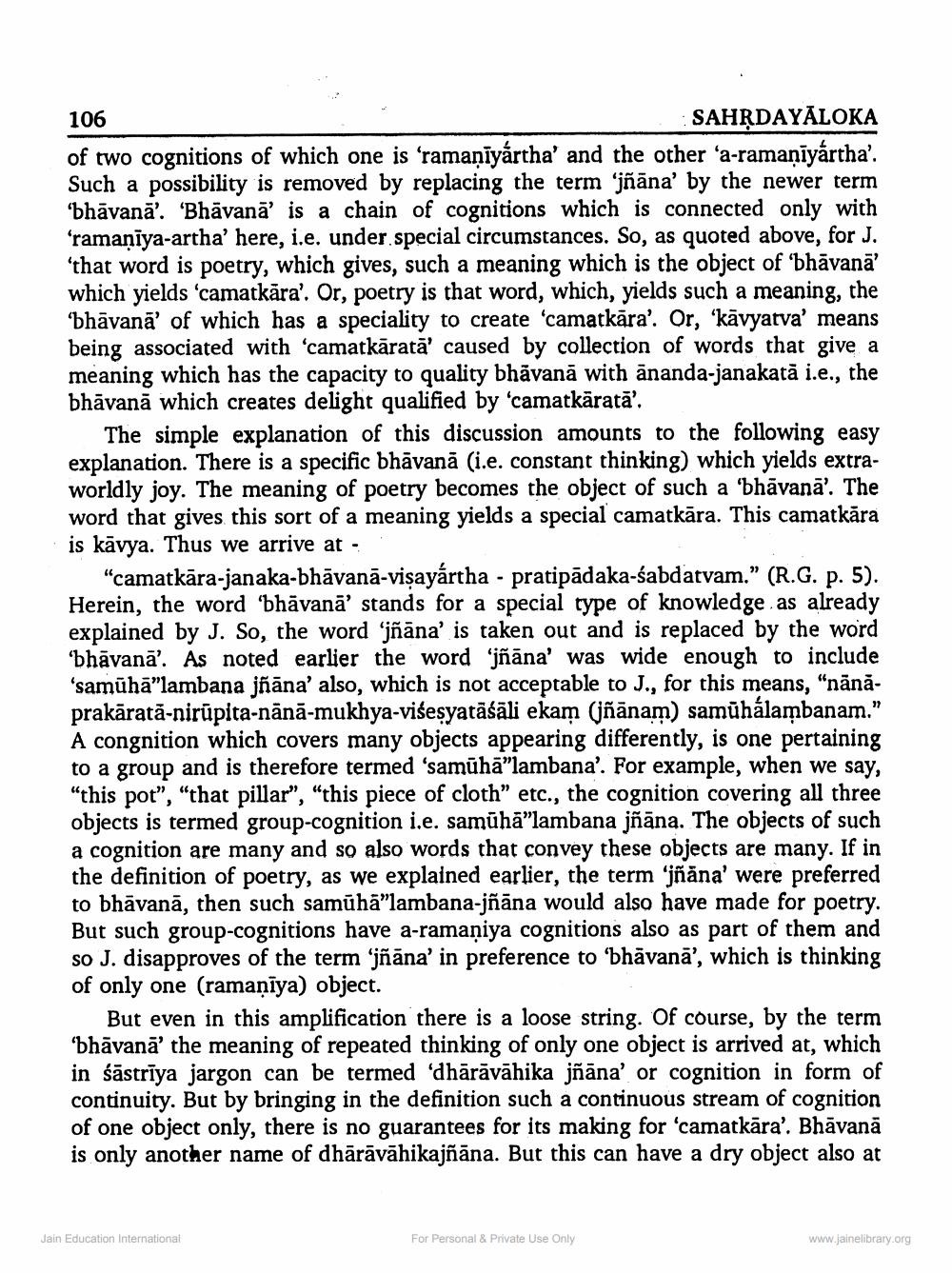________________
106
SAHRDAYALOKA of two cognitions of which one is 'ramanīyártha' and the other ‘a-ramanīyártha'. Such a possibility is removed by replacing the term 'jñāna' by the newer term 'bhāvanā'. 'Bhāvanā' is a chain of cognitions which is connected only with ‘ramaniya-artha' here, i.e. under special circumstances. So, as quoted above, for J. 'that word is poetry, which gives, such a meaning which is the object of 'bhāvana' which yields 'camatkāra'. Or, poetry is that word, which, yields such a meaning, the bhāvanā of which has a speciality to create 'camatkāra'. Or, ‘kāvyarva' means being associated with 'camatkāratā' caused by collection of words that give a meaning which has the capacity to quality bhāvanā with ānanda-janakatā i.e., the bhāvanā which creates delight qualified by 'camatkārata'.
The simple explanation of this discussion amounts to the following easy explanation. There is a specific bhāvanā (i.e. constant thinking) which yields extraworldly joy. The meaning of poetry becomes the object of such a bhāvanā'. The word that gives this sort of a meaning yields a special camatkāra. This camatkāra is kävya. Thus we arrive at !
"camatkāra-janaka-bhāvanā-visayártha - pratipādaka-śabdatvam.” (R.G. p. 5). Herein, the word 'bhāvanā' stands for a special type of knowledge as already
xplained by J. So, the word 'jñāna' is taken out and is replaced by the word 'bhāvanā'. As noted earlier the word 'jñāna' was wide enough to include 'samūhā"lambana jñāna' also, which is not acceptable to J., for this means, "nānā. prakārată-nirūpita-nānā-mukhya-višesyatāśāli ekam (jñānam) samūhálambanam." A congnition which covers many objects appearing differently, is one pertaining to a group and is therefore termed 'samūhā"lambana'. For example, when we say, "this pot", "that pillar”, “this piece of cloth” etc., the cognition covering all three objects is termed group-cognition i.e. samūhā"lambana jñāna. The objects of such a cognition are many and so also words that convey these objects are many. If in the definition of poetry, as we explained earlier, the term 'jñana' were preferred to bhāvanā, then such samūhā"lambana-jñāna would also have made for poetry. But such group-cognitions have a-ramaniya cognitions also as part of them and so J. disapproves of the term 'jñāna' in preference to 'bhāvanā', which is thinking of only one (ramanīya) object.
But even in this amplification there is a loose string. Of course, by the term 'bhāvanā' the meaning of repeated thinking of only one object is arrived at, which in śāstriya jargon can be termed 'dhārāvāhika jñāna' or cognition in form of continuity. But by bringing in the definition such a continuous stream of cognition of one object only, there is no guarantees for its making for 'camatkāra'. Bhāvanā is only another name of dhārāvāhikajñāna. But this can have a dry object also at
Jain Education International
For Personal & Private Use Only
www.jainelibrary.org




